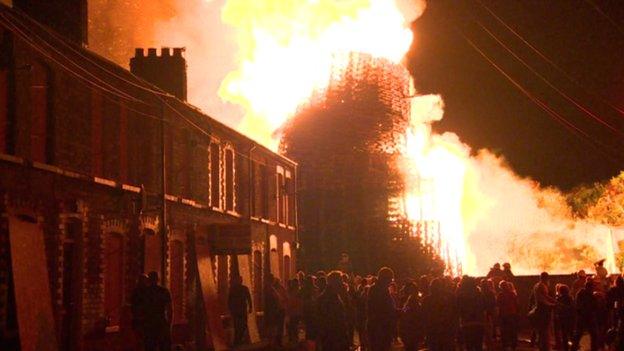The Twelfth: Thousands march in Orange Order parades
- Published
Thousands of Orange Order members have taken part in parades across Northern Ireland
Thousands of Orange Order members have taken part in parades across Northern Ireland.
The 12th of July parades mark the 326th anniversary of King William III's victory at the Battle of the Boyne in 1690.
A total of 18 demonstrations were held in towns and cities.
Northern Ireland's first and deputy minister and justice minister appealed for calm ahead of the parades.

Demonstrations were held across Northern Ireland
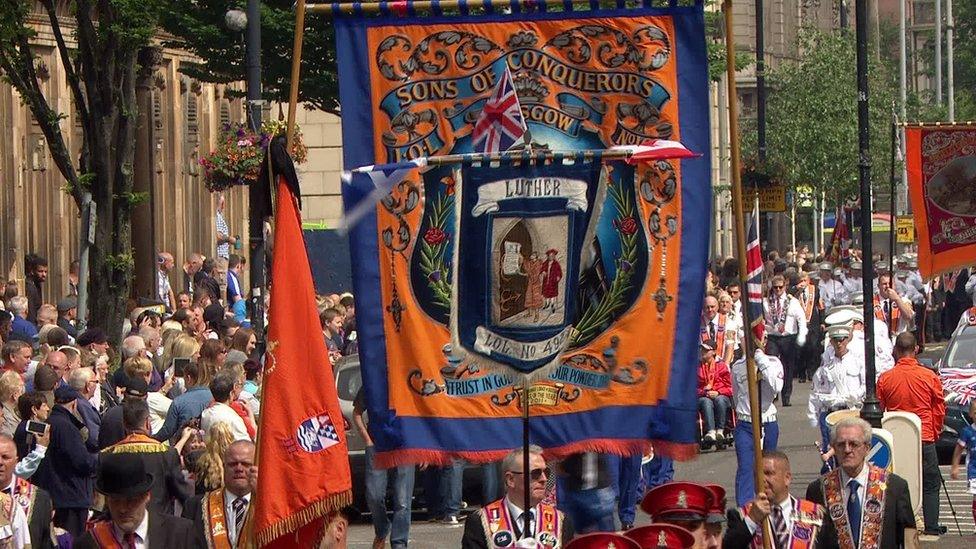
Orange Order members from Glasgow and further afield travelled to Belfast for the parade
In north Belfast, two nationalist residents' groups held separate protests against a feeder parade past the Ardoyne shops.
The stretch of Crumlin Road has been the scene of violence in recent years.
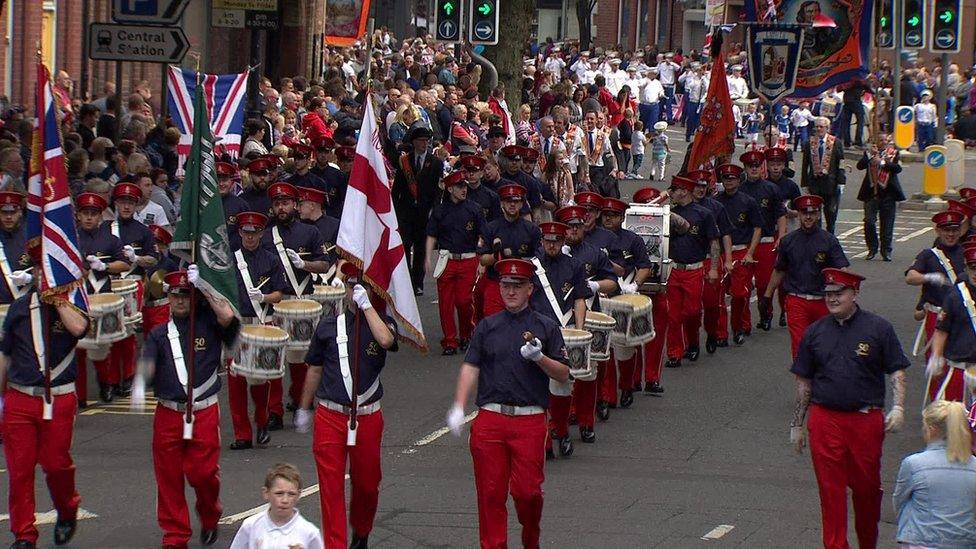
The main Belfast parade, traditionally the longest 12 July march, began at 10:00 BST
It was hoped a solution had been brokered to the long-running dispute last month, but the deal fell apart at the last minute.

Police in riot gear escorted an Orange Order feeder parade past nationalist protests in Ardoyne on Tuesday morning
On Tuesday morning, the feeder parade and the protests passed off without trouble.
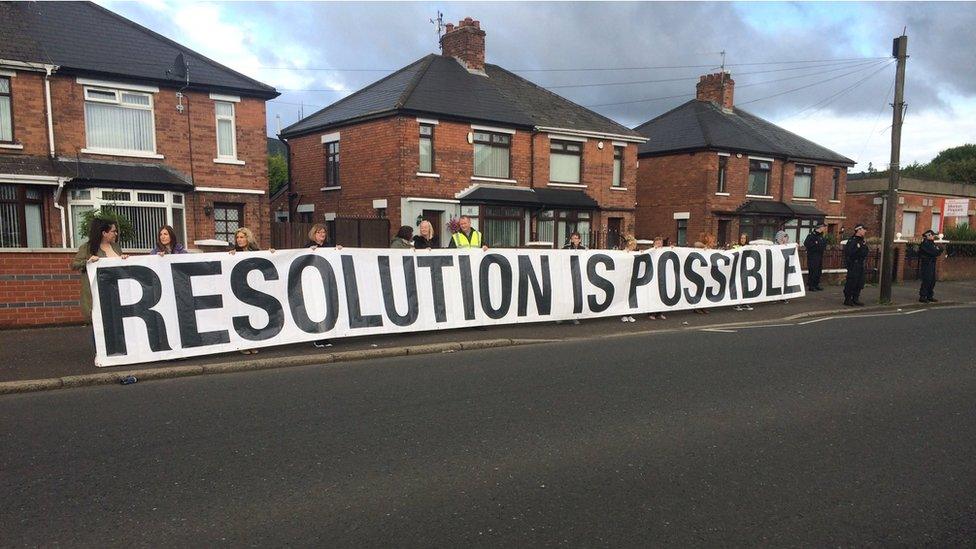
Nationalist residents' groups held protests against the parade on both sides of the road in Ardoyne
However, protesters at the Ardoyne shops heckled PSNI Chief Constable George Hamilton, shouting that he was not welcome in the area
This year, as has been the case since 2013, the feeder parade was not allowed to return by the same route on Tuesday evening.

Only a small number of members of Ballysillan lodge arrived at the barrier and they were not accompanied by any supporters
The return feeder parade passed off without incident.
A total of three lodges were due to march on the return leg but only one lodge turned up at the police barrier on the Woodvale Road.
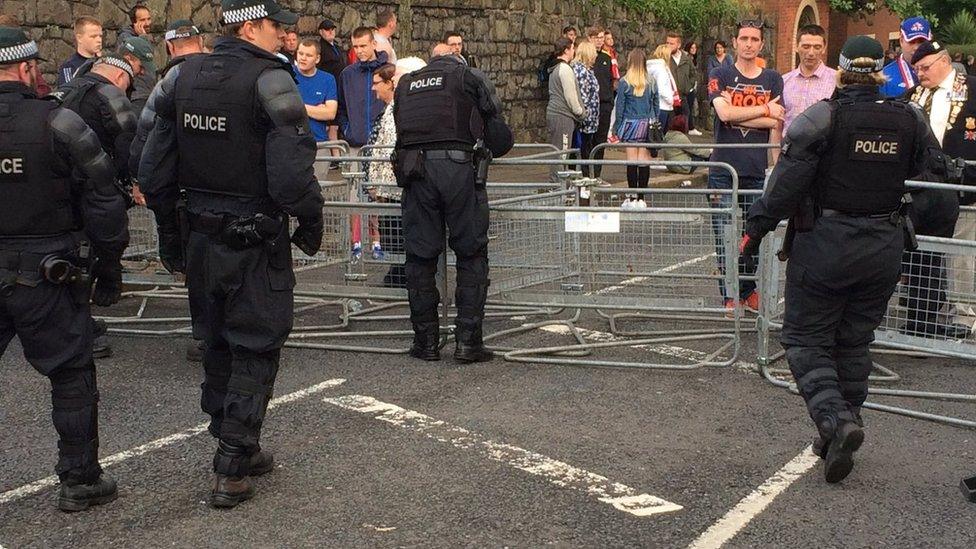
Police begin dismantling the barrier on the Woodvale Road after the return feeder parade passed on Tuesday evening
The Orange Order said the other two north Belfast lodges dispersed before the Woodvale Road barrier as they were outside the 20:30 BST deadline which had been set by the Parades Commission.
In east Belfast, around 30 bands took part in the return leg of the parade along the Lower Newtownards Road.
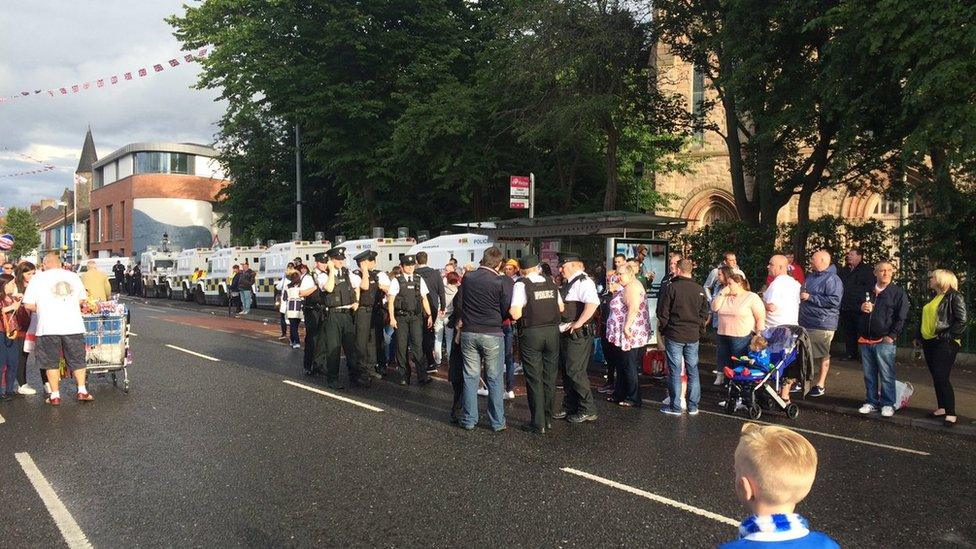
There was a large police presence on the Lower Newtownards Road in east Belfast ahead of the return parade
Several bands breached the Parades Commission ruling which stated that hymns could only be played between the junction at Short Strand to St Matthew's Church at Bryson Street.
There were security cordons and more than 20 landrovers but this part of the parade passed off without incident before heading onto Templemore Avenue.
The main Belfast march, which is traditionally the longest every year, left Carlisle Circus at 10:00 BST and made its way to the city hall.
The parade passed St Patrick's Catholic Church on Donegall Street without major incident.
Bands were told to only play a single drumbeat near the church, and most abided by the Parades Commission ruling.

The Parades Commission determination stated that bands should not play any music outside St Patrick's Church
However, one band played a hymn in the no-music zone and a small group of Orangemen sang a football song outside the church before they were stopped by fellow lodge members.
Sinn Féin's Carál Ní Chuilín said she was disappointed by the minor breaches of the Parades Commission ruling but was pleased with how the parade went as a whole.
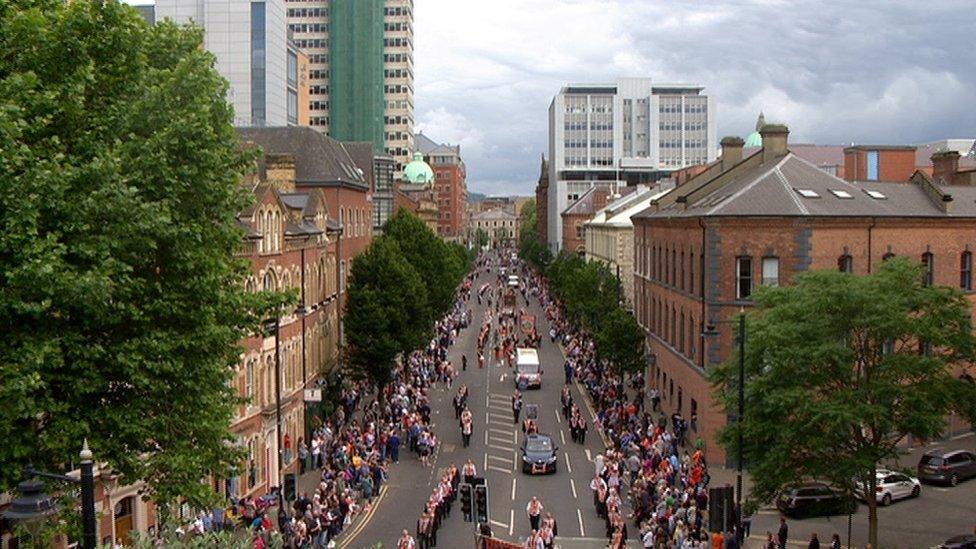
The parade passed through Belfast city centre on its way to the demonstration field
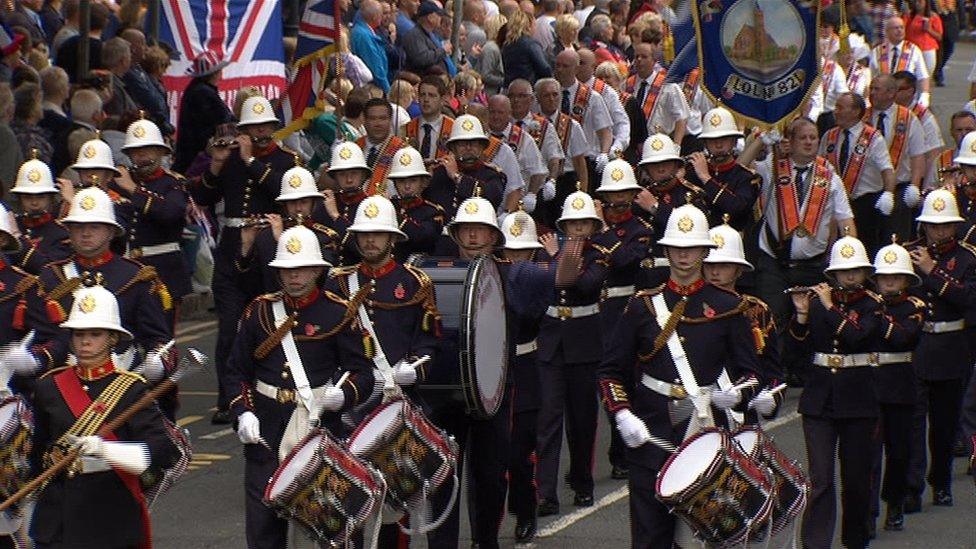
About 60 bands are walking the six-mile route through Belfast
When the parade reached Belfast City Hall, a wreath-laying ceremony was held at the cenotaph for servicemen and women who died during both World Wars and throughout the Troubles.
Tribute
This year the service marked the 100th anniversary of the Battle of the Somme and the soldiers who served with the 36th Ulster Division were commemorated.
The Orange Order also paid tribute to soldiers from all over the island of Ireland who died during the World War One battle.
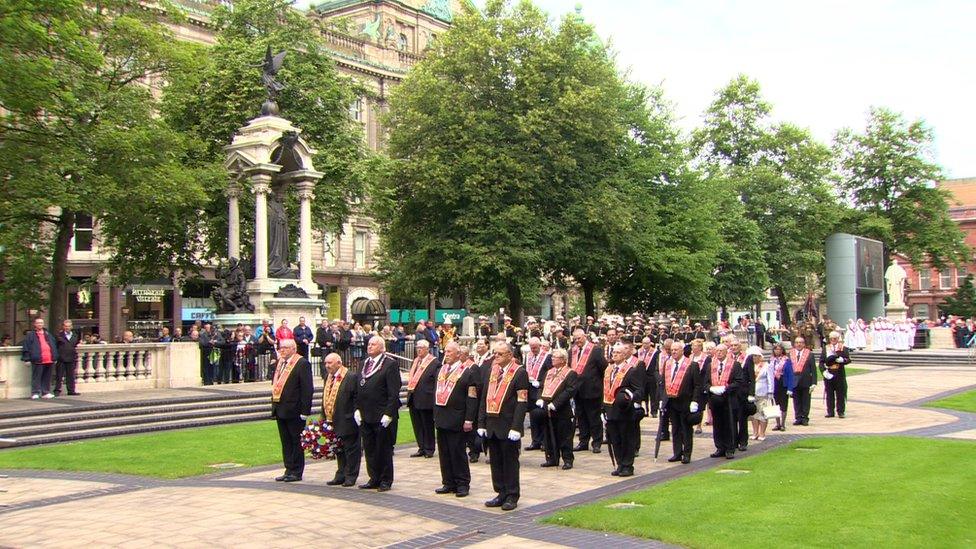
The march paused for a wreath-laying ceremony for the war dead in the grounds of Belfast City Hall
After the ceremony, the parade made its way south through the city centre to the demonstration field at Barnett Demesne.
About 60 bands walked the six-mile route.
Flagship
The parade left the field for the return leg at 16:15 BST.
Flagship parades were staged in Portadown, County Armagh and Kilkeel, County Down.
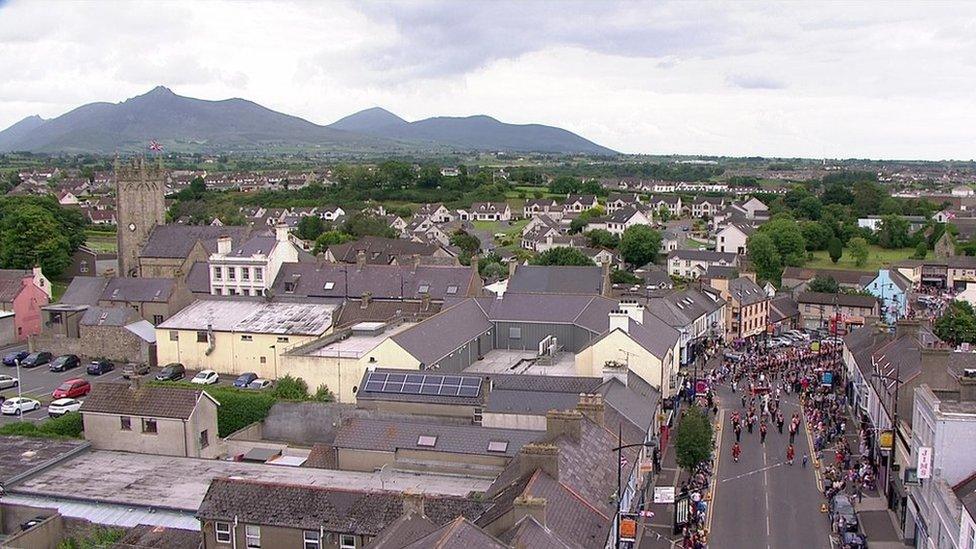
The Mourne Mountains provided a dramatic backdrop to the Kilkeel flagship parade
About 5,000 Orangemen and women took part in the Portadown event, with thousands of supporters lining the streets to watch the parade.
Portadown also marked the Battle of the Somme centenary with a carpet of poppies at the town's Cenotaph and a new Somme memorial gate at the demonstration field.
In Kilkeel, more than 1,000 Orange Order members marched through the town.
Mourne District Loyal Orange Lodge (LOL) Number 6 had 15 lodges on parade, according to historian, Dr Gavin Hughes, who took part in the BBC's live coverage of the event.

The local Orange Order lodges displayed their banners in Kilkeel
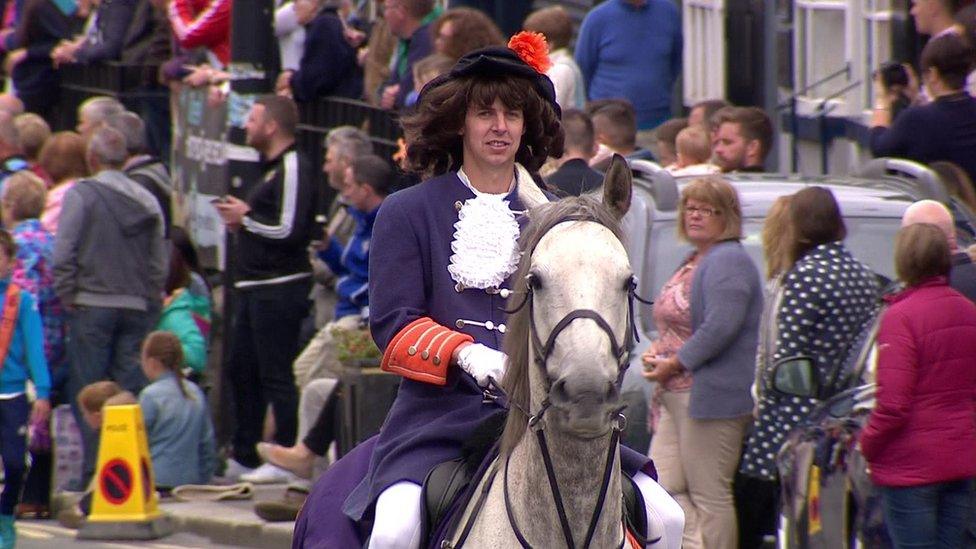
King Billy himself turned up for the Kilkeel parade
Grand Master of the Grand Orange Lodge of Ireland, Edward Stevenson, attended County Londonderry's largest parade in Limavady.
Approximately 3,000 Orangemen and women, representing 60 lodges, were accompanied by more than 50 bands.
The main procession began at 12:00 BST from Church Street.
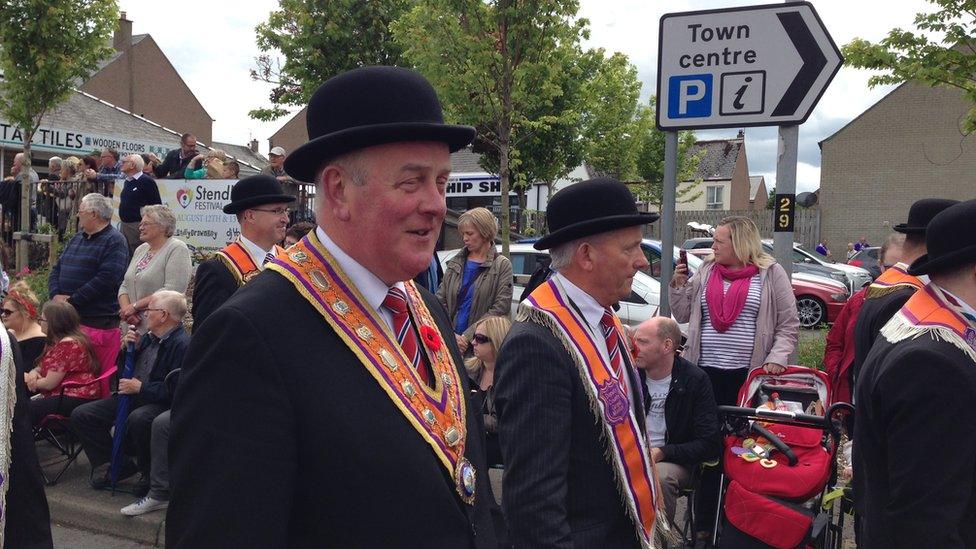
Grand Master Edward Stevenson attended the parade in Limavady
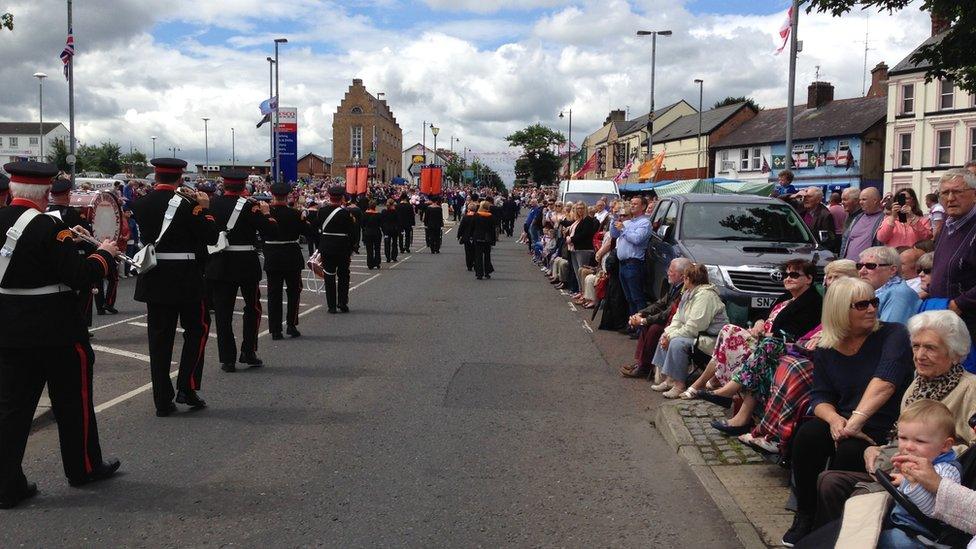
The parade in Limavady was the largest in County Londonderry
County Fermanagh's main Twelfth commemoration was held in the village of Maguiresbridge for the first time in 10 years.
A total of 15 Fermanagh district lodges were accompanied by a variety of marching bands.
'Celebration'
First Minister Arlene Foster attended the demonstration in Maguiresbridge and watched her children parade.
"This really is about celebration, it's about doing things in a way that we've done so for generations," she said.
"I always think of the Twelfth when I used to get two sandwiches in a plastic bag and a bun and that is still going on today but it is good fun and we really enjoy ourselves every year."
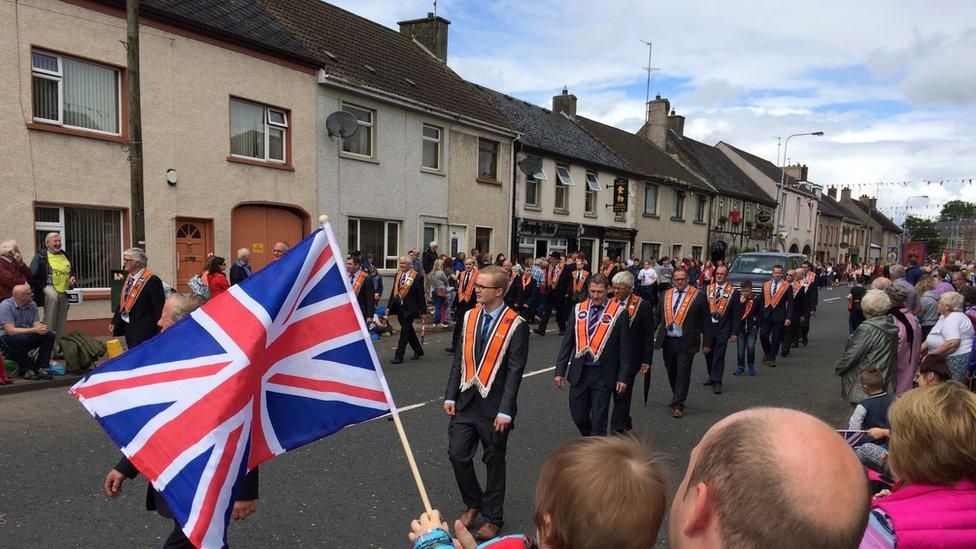
The village of Maguiresbridge hosted Fermanagh's main county demonstration for the first time in a decade
The Fermanagh Twelfth also hosted visiting lodges from the Republic of Ireland - including members from Donegal, Leitrim, Cavan and Monaghan.
The Orange Order said it hoped the event would attract many tourists to the lakeland venue.
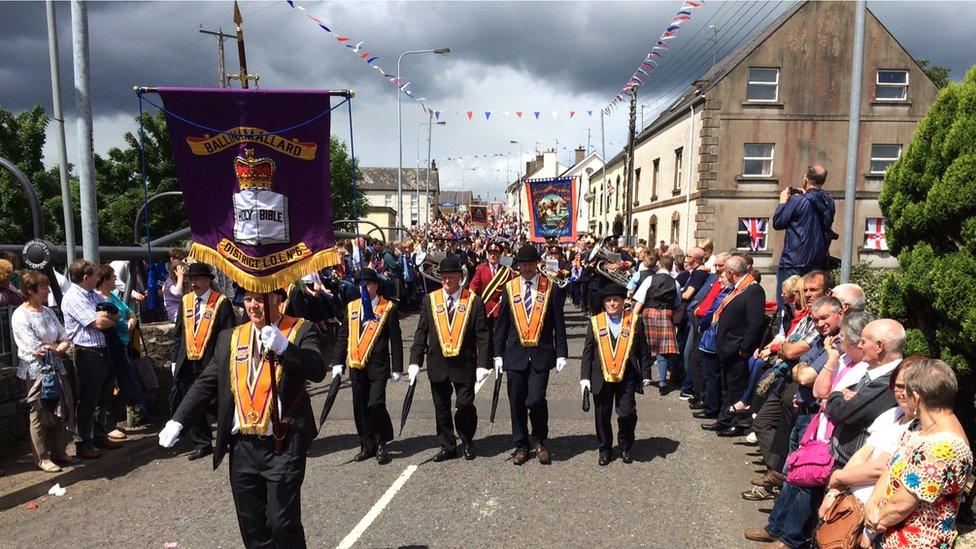
Maguiresbridge played host to local lodges and several visiting lodges from across the Irish border
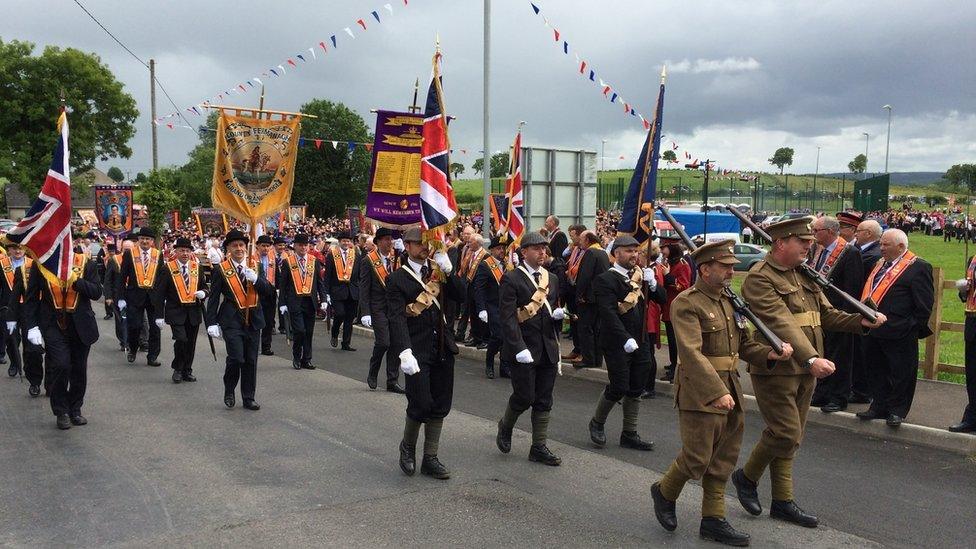
The Battle of the Somme centenary was also commemorated at the Maguiresbridge parade
North Antrim's Twelfth demonstration was staged in the coastal town of Ballycastle, where the guest of honour was one of the UK's most senior Orangemen - Grand Master of the Grand Orange Lodge of England, Ron Bather.
About a dozen protesters held small demonstrations along the parade route, which had been lined with Irish tricolours, éirígí flags and Palestinian flags.
Police spoke to one protester following a small scuffle during the march.
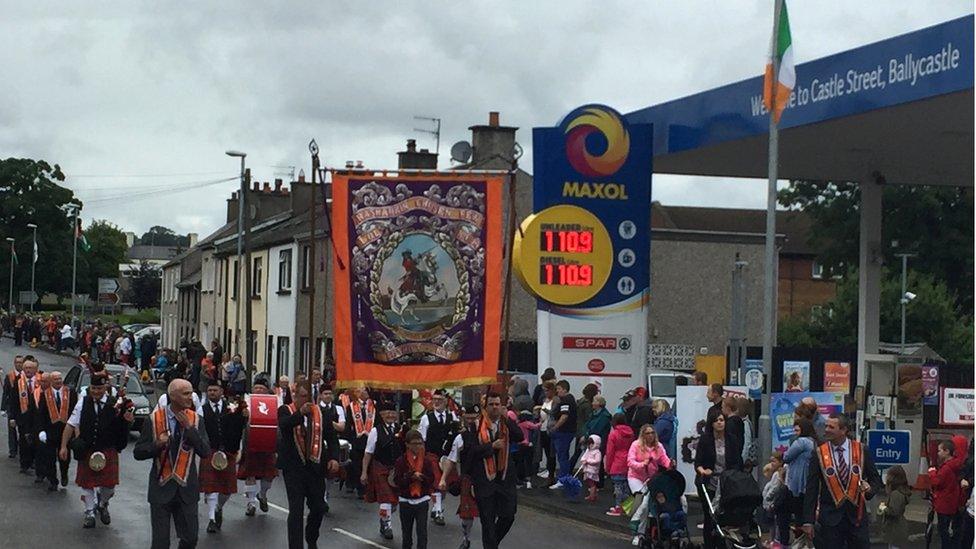
There were a small number of protesters and Irish tricolours along the Ballycastle parade route
- Published11 July 2016
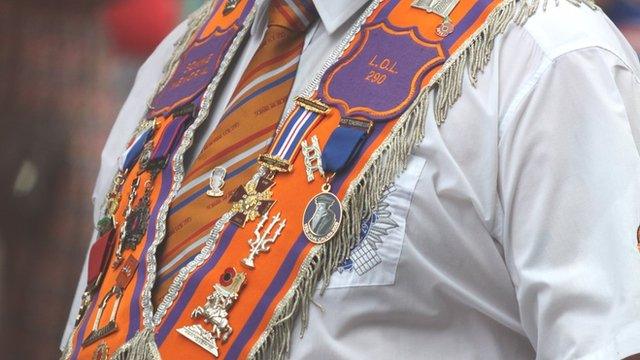
- Published11 July 2016

- Published9 July 2016
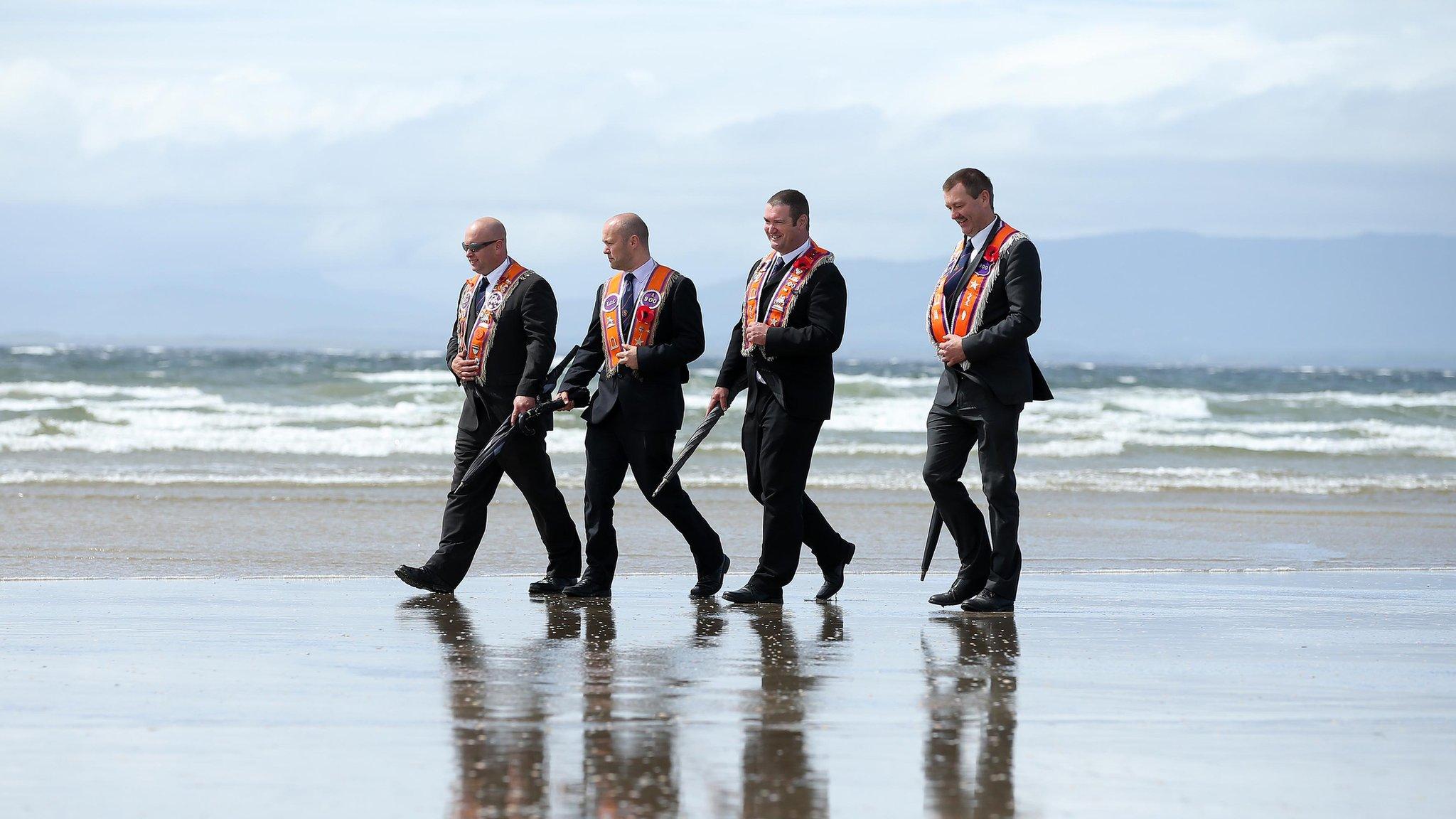
- Published1 July 2016
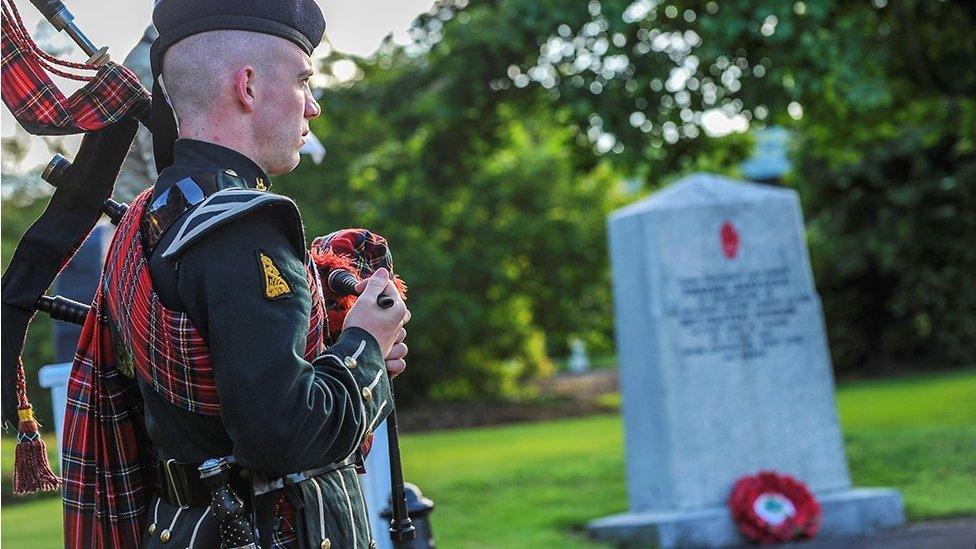
- Published11 July 2015
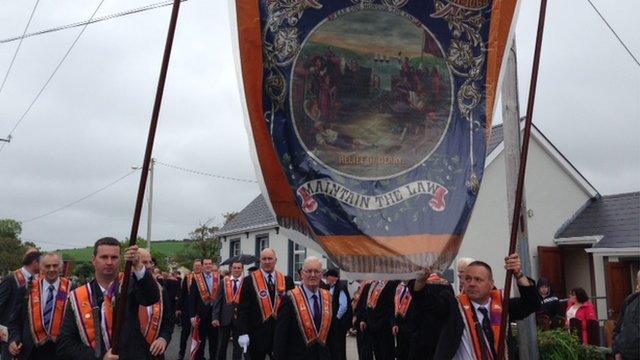
- Published11 July 2015
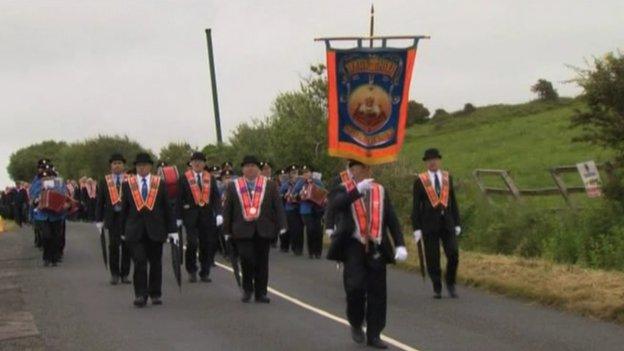
- Published12 July 2015
